Research - (2024) Volume 14, Issue 1
Improving maize productivity and food security through the application of organic amendments with liquid bio-slurry
Zekarias Yohannes1, Tarekegn Yoseph2*, Alemayehu Kiflu2, Tewodros Ayalew2 and Ashenaf Haile2Abstract
Increasing maize production is vital for contributing to smallholder farmers' food security since it ranks second in production after wheat. However, the decline in soil fertility is a marked constraint to crop productivity in developing countries, particularly in maize production. Recently, organic amendments through liquid bio-slurry enhanced maize productivity and improved food security via changes in soil physico-chemical properties for smallholder farmers in developing countries like Ethiopia. However, the utilization of liquid bio-slurry as an organic amendment has not been extensively investigated in the study areas. Therefore, field experiments were conducted at two sites to determine the optimum combination of inorganic N and liquid bio-slurry for improving maize productivity. A factorial combination of two mineral N (0 and 46 kg ha-1) and five liquid bio-slurry (0, 6, 12, 18 and 24 t ha-1) rates were used in a randomized complete block design with three replications. The results revealed that the combined use of N and liquid bio-slurry improved the growth and yield of maize in the two experimental sites. Plant height, ear length, number of rows per ear, number of kernels per ear, above-ground dry biomass, hundred-grain weight, grain yield and straw yield of maize were all improved by applying 46 kg N ha-1 along with 18 t liquid bio-slurry ha-1. The highest grain yield (8.12 t ha-1) was achieved from the combined application of 46 kg N ha-1 with 18 t liquid bio-slurry ha-1. Thus, using 46 kg N ha-1 with 18 t liquid bio-slurry ha-1 is highly recommended to increase the yield of maize.
Keywords
Food security, Grain yield, Liquid bio-slurry, Productivity, Soil amendment.
Introduction
Food security is often characterized as the availability and accessibility of nutritionally sufficient and safe food or the ability to obtain socially acceptable food (Andersen, SA. 1990; Zhou, D., et al., 2019). Household food security is related to the ability to purchase enough high-quality food to meet the nutritional needs of all household members and it is primarily determined by economic freedom and purchasing power (Endalew et al., 2015). In this regard, increasing the productivity of maize is critical to increasing the food security of smallholder farmers, as maize is the second most widely produced cereal crop globally after wheat (FAO, 2019). Nevertheless, the average maize yield in the country stands at approximately 4.2 t ha-1 (CSA, 2019), significantly lower than the global average yield of 5.8 t ha-1 (FAO, 2019). Several factors have been listed for the limited productivity of maize, among which low external inputs, particularly N, declining soil fertility, which contributed to poor soil fertility, reduced water-holding capacity and poor soil infiltration, are among the major factors (Chimdi et al., 2012; Teklewold et al., 2013). Declining soil fertility is a major
barrier in most developing countries, leading to severe food insecurity and poverty (Martey et al., 2019). Increasing crop productivity remains the most pressing challenge in the region to feed an ever-increasing population by 2050 (Dimkpa, CO., et al., 2020). To counteract such multifaceted issues and improve food and nutritional security, effective soil fertility improvement strategies are required (Martey, E., et al., 2019; Maje, S., et al., 2021).
More than 80% of Ethiopians earn their livelihoods through agriculture based on soil, nevertheless, 31% of the country's agricultural land has already become degraded (Spiertz, JHJ. 2009). Degradation of soil fertility has been an impediment to sustainable agricultural productivity for farmers with limited resources (Negassa, W., et al., 2007. Gelaw, AM., et al. 2014) explain that one of the main factors causing the decline in soil fertility and productivity is the loss of soil organic matter as a result of topsoil erosion combined with unfavorable physicochemical characteristics. Sustainable agriculture production depends on the judicious and balanced use of external inputs together with environmentally friendly soil management practices (Sanjivkumar V., 2014). According to Lal, R. 2015, the application of better soil management techniques may have an impact on the stability, quality and sustainable use of soil resources, thereby contributing to the productivity of crops.
In conventional farming, mineral fertilizers are considered the foremost option to overcome the problem of nutrient depletion and sustain food production (Elka, E and Laekemariam, F. 2020). However, excessive use of inorganic fertilizers does not always translate into a proportional increase in crop yield (Powlson, DS., et al., 2008), but instead results in additional costs and efforts. Continuous application of inorganic fertilizer has been shown to lower crop productivity and soil fertility (Chaudhary, S., et al., 2017). The use of organic inputs alone is not sufficient to increase crop yields and satisfy the food needs of humankind due to their slow-release nature and will not fully deliver the required quantities of nutrients via plants (Salim, MS., et al., 1998). Maltsev, K and Yermolaev, O. 2020, found that soil degradation significantly affects food security and increases atmospheric CO2 emissions. The constant and continuous application of inorganic fertilizers has also led to the regular absorption and accumulation of heavy metals in plant tissues, lowering the nutritional value of crops (Maqbool, A., et al., 2020).
Integrated use of organic inputs and mineral fertilizers typically improves crop yield (Fairhurst, T. 2012; Mugwe, J., et al., 2019). Several researchers have commented on the economic benefits of integrated nutrient management (Ashoka, P., et al., 2008; Naik, IA and Gupta, AJ. 2010). According to Jinwei, ZHAO and Lianren, ZHAO. 2011, an integrated application of organic and chemical fertilizers lowered fertilizer costs compared to a solitary application of either fertilizer. Saleem, M., et al. 2017 also observed the highest net benefit (78,419.66 ha-1) of mono-cropped maize with a combination of 50% poultry manure + 50% PK + inoculation compared to either fertilizer applied alone. A significant increase in crop yield has been observed when liquid bio-slurry is applied with chemical fertilizer (Warnars, L and Oppenoorth, H. 2014). Moreover, the positive effect of bio-slurry has been examined in different crops, including wheat (Warnars, L and Oppenoorth, H. 2014), rice (Islam, MA., et al., 2014), barley (Warnars, L and Oppenoorth, H. 2014), millet (Warnars, L and Oppenoorth, H. 2014) and vegetables (Islam, MS. 2006; Islam, MR., et al., 2010). Therefore, this study was conducted to determine the effect of mineral N fertilizer and liquid bio-slurry on the growth and yield response of maize and identify the economically feasible combination that gives the maximum yield and economic benefit to maize producers.
Material and Methods
Description of study sites
The experiment was conducted in Wondo Genet and Hawassa University Research site (Fig. 1).
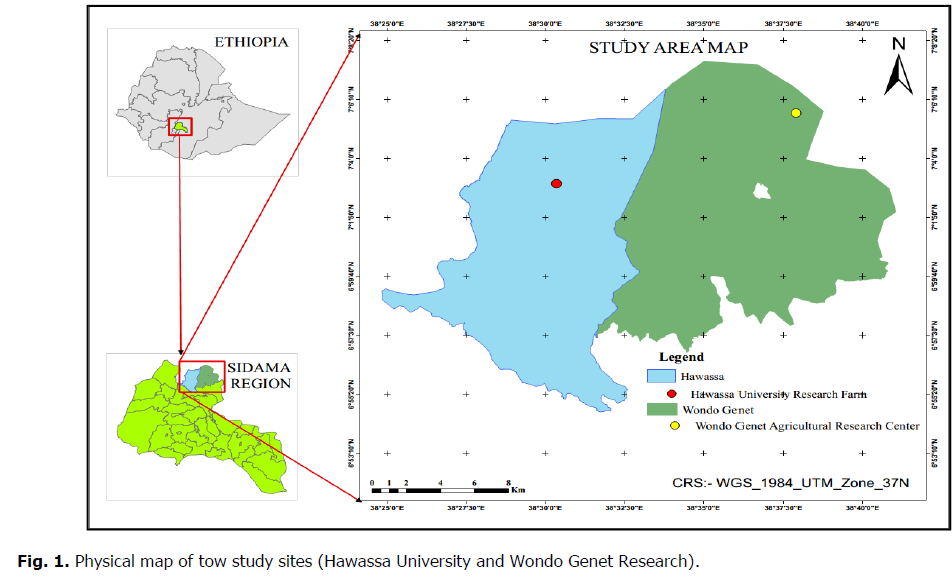
Fig. 1. Physical map of tow study sites (Hawassa University and Wondo Genet Research).
Experimental site one: The Hawassa site is situated at 7°3′N latitude and 38°28′E longitude, 275 km south of Addis Ababa. It is 1700 metres above sea level (m.a.s.l.). The area had a bimodal rainfall distribution pattern, expected from March to April and June to August (Kebede, W., et al., 2014). According to Markos, D., et al. 2023 the predominant soil in this location is classified as a vitric andosol.
Experimental site two: Site The Wondo Genet study site is located 14 km southeast of Shashemene town and 270 km south of Addis Ababa. The site is 1780 metres above sea level and is found at 7°19′N and 38°38′E. The site had a bimodal rainfall pattern, expected from March to May and June to October (Gebregeorgis, EG., et al., 2018). Mollic andosol with a sandy-loam texture dominates the site's soil (Yimer, F. 2017). The distance between Hawassa and Wondo Genet is 32 km by road.
The majority of the local population's income comes from mixed-subsistence farming around the study areas. Enset, haricot bean, teff, wheat, khat and maize are the dominantly produced crops in the study area.
Climatic data of the study sites
Fig. 2 depicts the mean monthly rainfall and highest and lowest temperatures at the research sited for the main cropping season of 2021/22. At Wondo Genet, the highest mean monthly rainfall was recorded in September/February, whereas at Hawassa, it was higher in August/October. At Wondo Genet, the highest and lowest mean maximum and minimum temperatures were recorded in [February and July] and [July and November]. At the Hawassa, the values were higher in [March and August] and [November and August], respectively.
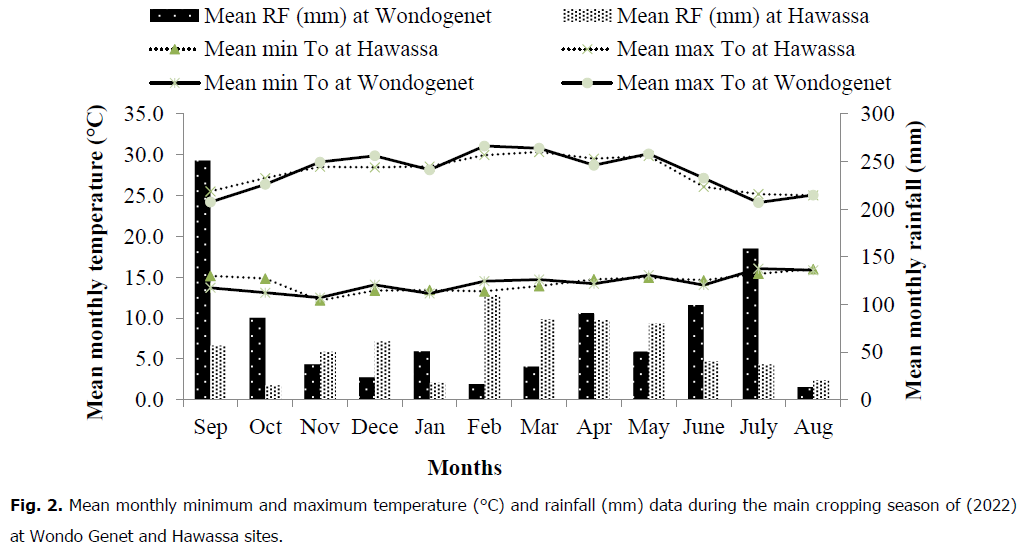
Fig. 2. Mean monthly minimum and maximum temperature (°C) and rainfall (mm) data during the main cropping season of (2022) at Wondo Genet and Hawassa sites.
Description of the experimental materials
In this study, the SBRH-2016 variety of maize was used and its seed rate was 25-30 kg-1. The variety was selected because it was considered suitable for the study area and had potential for productivity. The liquid bio-slurry was used as an organic nutrient supply, while urea was used as a source of mineral N. Throughout the crop's growth period, the appropriate dosage of P in the form of TSP and other factors were applied continuously. The experiment's liquid bio-slurry was comprised of 93% water and 7% dry matter. The rates were adjusted in accordance with the recommended rate of N.
Liquid bio-slurry preparation and analysis
Liquid bio-slurry was collected from the private hotel in Hawassa town and analyzed to determine its nutrient contents before being applied to the two site soils. The ratio was prepared in the tank of the bio-digester and stirred in a circular movement with a stick using the methods described by Ognjenović, M., et al. 2022. During the preparation, preventive measures were taken to avoid scraping off the bottom and corners of the tank. Then five representative liquid bio-slurry samples were collected with 2 L of sampling plastic. The samples were mixed in the plastic container and a 1L representative sample was taken for chemical analysis such as pH, Organic Carbon (OC%), Total Nitrogen (TN%), available phosphorus (Av P ppm) and available potassium (Av K ppm) in the soil laboratory of Hawassa Agricultural Research Centre by following laboratory procedures listed in soil analysis (Table 1).
| Property | Value | ||
|---|---|---|---|
| Soil | Bio-slurry | ||
| Wondogenet | Hawassa | ||
| Chemcial | |||
| Total nitrogen (%) | 0.11 | 1.13 | 1.51 |
| Available P (mg P2O5/kg soil) | 21.73 | 14.73 | 103.7 |
| Available K (mg P2O5/kg soil) | 169 | 174 | 195.0 |
| Organic matter (%) | 3.01 | 2.84 | 29.76 |
| pH.H2O (1:2.5) | 6.98 | 7.15 | 7.29 |
| Exch. Ca2+(cmol/kg soil) | 9.21 | 13.21 | 14.4 |
| Exch. Na+(cmol/kg soil) | 0.57 | 0.97 | 1.60 |
| Exch. K+(cmol/kg soil) | 0.53 | 1.13 | 1.18 |
| Exch. Mg2+(cmol/kg soil) | 2.93 | 2.63 | 7.20 |
| CEC (cmol/kg soil) | 20.93 | 23.26 | 61.00 |
| Organic carbon (%) | 1.75 | 1.65 | 17.30 |
| Physical | |||
| Sand (%) | 31 | 58 | 93.13% Water |
| Silt (%) | 32 | 20 | 6.87% Dry matter |
| Clay (%) | 37 | 22 | - |
| Textural class | Clay Loam | Sandy Loam | - |
Table 1. The physico-chemical properties of the two experimental site soil and bio-slurry.
Soil sampling and analysis
Selected soil physico-chemical properties of study sites: Prior to planting, soil samples were collected from 0-30 cm depth from twelve points across the experimental field in a zigzag manner by using a screw auger. After removing gravel materials, dead plants, old manures and clogs, were composited and quartered until obtaining a kg composite soil sample. The composite sample was then air-dried under shade, ground with a pestle and mortar, packed in paper bags and labeled. The sample was pulverized and sieved through a 2 mm sieve after being air-dried at room temperature. However, 0.5 mm mesh wire was used for the determination of Organic Carbon (OC) and Total Nitrogen (TN). Then, the selected soil physico-chemical properties [soil texture, soil pH, total Nitrogen (N), organic carbon content, available Phosphorus (P), exchangeable cations and Cation Exchangeable (CEC)] at the start of the experiment were analyzed at Soil Laboratory of Hawassa University College of Agriculture (Table 1). Soil analysis results revealed that the Hawassa and Wondo Genet sites had clay loam textural classes (Hazelton, P and Murphy, B. 2007). The soil pH of both study sites was neutral, indicating that there was no acidity problem and that nutrient availability for crop production was adequate (Karltun, E., et al., 2014). The available P contents [14.73 and 21.73 mg kg-1] at both experimental sites were rated as low and medium, respectively (Olsen, SR., et al., 1954). The low P content at the Hawassa site could be due to crop utilization or uptake due to low or no P-containing fertilizer application. Farmers are thus advised to use soil amendments such as P-containing fertilizers or organic sources to improve soil fertility, which will increase maize crop production and productivity. The exchangeable bases were rated from medium to high at both experimental sites. The higher availability of exchangeable bases may be attributed to the sites' neutral soil reaction, which creates ideal conditions for their availability (McCauley, A., et al., 2009). The total N content in the soil at Hawassa and Wondo Genet were rated as medium for both sites whereas OC rated as low at Hawassa site and medium at Wondo Genet site (Landon, JR. 1991). The low OC and medium total N contents in the study area indicate that the soil is not fertile. This could be related to continuous cultivation, a lack of organic material integration and a substantially higher temperature during the study period.
Chemical composition of liquid bio-slurry: The liquid bio-slurry used for the experiment had a pH value falling within the neutral range. Its neutrality is good for agronomic practices since it reduces the acidity problem of experimented sites and makes it ideal for the growth of maize crops by releasing essential macro and micronutrients. In line with this result, Mwanga, KE. 2016, reported that applying liquid bio-slurry reduce the acidity problem of the soils and improves the quality of agricultural soil by neutralizing acidic condition. It also contained a high OC, which is critical for maintaining nutritional balance by limiting the movement of heavy metals and accelerating the decomposition of organic matter (Ibukunoluwa Moyin-Jesu, E. 2015).
Furthermore, it improves overall soil CEC and increases soils' ability to retain exchangeable cations, making fertilization more efficient. Total N and available P contents were high in the applied liquid bio-slurry, indicating that its application can supply the soil with those essential nutrients. Similar finding was reported by Muraishi, CT., et al. 2011 and Hariadi, YC., et al. 2016. Exchangeable bases and CEC of liquid bio-slurry were classified under the high ranges this might be because of its neutral nature which in turn improves soil acidity.
Treatments and experimental design
The treatments consisted of two N (0 and 46 N kg ha-1) rates and five different rates of liquid bio-slurry (0, 6, 12, 18 and 24 t ha-1). The treatments were combined factorially, giving a total of 10 treatment combinations. The design of the experiment used was Randomized Complete Block Design (RCBD) with three replications. A uniform plot size of 3.5 m × 2.4 m (8.4 m2) was used for each unit, with a total experimental area of 363.4 m2. The blocks were separated by 1 m in width, whereas the space between each plot within a block was 0.5 m. In each plot, there were five rows and 16 plants per row, for a total of 80 plants per plot before thinning to remaining of one plant per hole. In accordance with the specifications of the design, each treatment was assigned randomly to experimental units within a block. The middle three rows from each plot were used for yield determination, while the outermost rows were kept as border plants.
Agronomic practices
The land preparations at the two experimental sites were done by performing conventional tillage with three plowings by tractor at a depth of 30 cm. Level formation was done manually using a rake during plot preparation. Nitrogen (Urea 46% N) was applied in two equal splits, half at planting and the other half after 40 days of plant emergence, with band application approximately 5 cm away from the maize plant to control the burning effect of the plant. Phosphorus was applied at sowing. The full dose of the liquid bio-slurry was applied four weeks before sowing. All cultural and agronomic practices except fertilization, such as hoeing, disease, insect and weed management, were performed uniformly for all plots in both study sites.
Data collection and measurements
Phenological parameters: Days to 50% tasseling were recorded from the days to emergence to the days when 50% of the maize plants produce tassels in each plot. Days to 50% silking were recorded from the date of emergence to the date when 50% of the maize plants produce silk in each plot. Days to 90% physiological maturity were recorded from the days of emergence to the days when 75% of the maize plants in a plot raised the formation of the black layer at the point of attachment of the kernel with the cob.
Growth parameters: Plant height was measured from the ground level to the collar of the upper leaf with a developed leaf sheath at emergency of the flower stalk. The total number of leaves per plant was counted from the sampled plants for plant height and averaged to determine the leaf number per plant. Leaf area was measured by using a leaf area metre (Model LI-310 °C) at emergency of the flower stalk. The leaf area index was determined as the ratio of the leaf area to the ground area of the plant.
Yield and yield components: The number of ears per plant was determined by dividing the number of harvested ears by the number of harvested stands. Ear length was measured from the point where ears were attached to the stalk to the tip of the ear with a glass ruler after harvest. Ear diameter was measured with a caliper in the middle of the ear. To determine the kernel number per ear, the first shelled grain of the harvested maize in each plot was weighed and divided by the number of ears. The number of rows per ear was determined by dividing the number of rows by the number of harvested ears. To determine the kernel number per ear, the shelled grain of the harvested maize in each plot was weighed and divided by the number of ears. The hundred-grain weight was determined by weighing 100 sampled grains from the bulk harvest and adjusting to a 12.5% moisture level. Grain and straw yield data were collected from the three harvestable rows by excluding the border plants. The harvested biomass was weighed for fresh biomass weight, after which the ears and the straws were separated and weighed. The grain yield was determined by adjusting the moisture content to 12.5%. Straws of two stands from each plot were collected from each plot at harvest. The straw samples were oven-dried until a constant weight was attained so that it was possible to calculate the dry straw yield per plot. The dried biomass yield was determined as the sum of dry grain and dry straw yields.
Statistical data analysis: The data recorded for each of the parameters considered in this study were subjected to analysis of variance (ANOVA) using a General Linear Model in SAS software and mean separation was made based on LSD at 5% (P<0.05) level of significance. The Hartley, Fmax test method was used to evaluate the homogeneity of error variances test for all parameters before performing a mean analysis across two sites.

The mineral N fertilizer and liquid bio-slurry were considered fixed factors, whereas the sites were random factors. The error variances were considered homogeneous because the highest Error Mean Square (EMS) was not threefold larger than the smallest EMS and a combined ANOVA was performed on the data from the two sites because the Fmax<3.00 test indicated that all parameter data were homogeneous across the sites by Gomez and Gomez.
Results and Discussion
Phenology parameters
The effects of mineral N fertilizer and liquid bio-slurry had a highly significant (P≤0.001) effect on the days to tasseling, silking and maturity of maize. The longest days to tasseling, silking and maturity were recorded from the 46 kg ha-1 of N and the shortest were recorded from the control treatment (Table 2). The data pertaining to Tasseling, silking and maturity were delayed by 7.13, 6.99 and 7.94 days, respectively, when 46 kg N ha-1 was applied. This clearly indicates that the applied nitrogen promotes vegetative growth, resulting in a longer duration of the tested phenological parameters and a higher rate of mineral N fertilizer over the control. Nitrogen also increased the chlorophyll content of a maize plant, retaining soil moisture content for an extended period, thereby affecting the phenological parameters. Similarly, trends were also observed by Egamberdieva, D., et al. 2016 with higher rates of mineral N fertilizer. In addition, Shrestha, J. 2013 and Anwar, S., et al. 2017 also found that increasing the amount of mineral N fertilizer slowed the crop's phenological process.
| Parameters | Days to tasseling | Days to silking | Days to maturity |
|---|---|---|---|
| Mineral N (kg ha-1) | |||
| 0 | 82.1b | 85.14b | 125.69b |
| 100 | 88.74a | 92.38a | 133.63a |
| LSD (0.05) | 1.36 | 0.85 | 3.14 |
| Level of Significance | ** | ** | ** |
| Liquid bio-slurry (t ha-1) | |||
| 0 | 80.51c | 82.77c | 123.71d |
| 6 | 84.63b | 88.68b | 126.07cd |
| 12 | 86.13ab | 90.23a | 131.28bc |
| 18 | 88.74a | 91.53a | 136.23a |
| 24 | 87.81a | 90.61a | 131.01ab |
| LSD(0.05) | 2.16 | 1.35 | 4.97 |
| Level of Significance | ** | ** | ** |
| CV (%) | 3.1 | 1.84 | 4.64 |
Table 2. Effects of mineral N fertilizer and liquid bio-slurry rates on phenological parameters of maize averaged across two sites.
With regard to bio-slurry treatment, the extended phenological parameters of maize were recorded from the applications of 18 and 24 t ha-1 liquid bio-slurry and the shortest was obtained from the control treatment (Table 2). The application of the maximum rate of liquid bio-slurry delayed the phenology of maize because it improved the soil's macro- and micronutrient content, which supported the crop's normal physiology and delayed the phenology and growth performance of the crop. Similarly Birara Endalew, BE., et al. 2015 found that the production of silk or tassel was delayed in maize plots receiving higher amounts of N fertilizer from organic or mineral sources. On the other hand, it was noted by Dawadi, DR and Sah, SK. 2012 and Jassal, RK., et al. 2017 that earlier tasseling and silking were caused by greater N levels.
Growth parameters
Plant height: The interaction effects of mineral nitrogen and liquid bio-slurry had a highly significant effect (P≤0.01) on the plant height of maize (Fig. 3). The combined application of 46 kg N ha-1 with 18 t ha-1, followed by 24 and 12 t ha-1 liquid bio-slurry, resulted in the highest plant height, while the shortest plant height was recorded from the control treatment. Such improvement in plant height could be attributed to a synergistic effect of mineral N and liquid bio-slurry rates. The combined application of N and bio-slurry improved soil aeration, root penetration and water storage capacity by improving CEC and reducing P fixation; these effects ultimately led to an increase in plant height (Shahbaz, M., et al., 2014). As a result, it creates favorable conditions for maize production and promotes plant growth, which is consistent with our findings. The result is also in line with the finding of Mitiku, who found a significant effect of plant height on the integrated use of organic and inorganic fertilizers. Similarly, Woubshet found that combining lime with inorganic fertilizer and compost improved plant height in barley. Furthermore, Habtamu, A., et al. 2019 reported significantly improved plant height in maize after applying 10 t ha-1 FYM combined with 150 kg N ha-1.
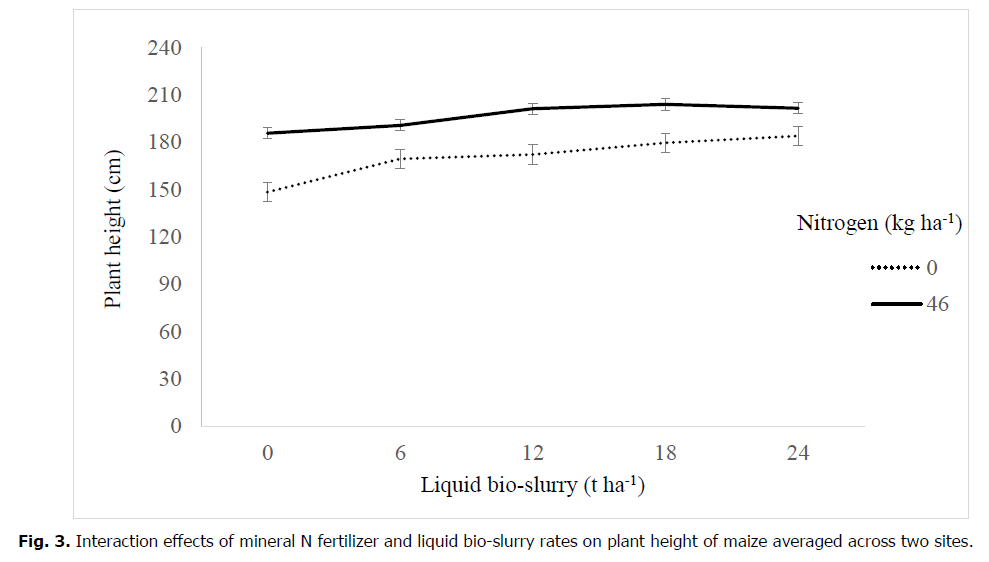
Fig. 3. Interaction effects of mineral N fertilizer and liquid bio-slurry rates on plant height of maize averaged across two sites.
Leaf attributes: Leaf characters (number of leaves, leaf area and leaf area index) are an important factor in biomass yield, which is significantly influenced by soil nutrition, particularly N. The averaged results from the two experimental sites revealed that the main effects of N and liquid bio-slurry rates had a highly significant (P≤0.01) effect on the leaf characteristics of maize. The maximum values of these traits were recorded from the use of 46 kg ha-1 of N. The minimum values were recorded for the control treatment. The supplied mineral N fertilizer increased the number of leaves, leaf area and leaf area index by 9.73, 25.30 and 25.0%, respectively, compared with the control (Table 3).
| Parameters | Number of leaves plant-1 | Leaf area (cm2) | Leaf area index |
|---|---|---|---|
| Mineral N (kg ha-1) | |||
| 0 | 12.88 b | 6686.90 b | 3.20 b |
| 100 | 14.13 a | 8377.30 a | 3.99 a |
| LSD (0.05) | 0.5454 | 312.33 | 0.1467 |
| Level of Significance | ** | ** | ** |
| Liquid bio-slurry (t ha-1) | |||
| 0 | 12.38 c | 6346.10c | 3.06c |
| 6 | 13.76bc | 7374.3 b | 3.51 b |
| 12 | 13.76a b | 7533.30 b | 3.59 b |
| 18 | 14.32 a | 8067.50 a | 3.84 a |
| 24 | 14.14 a | 8339.2 a | 3.97 a |
| LSD (0.05) | 0.8624 | 493.84 | 0.2319 |
| Level of Significance | ** | ** | ** |
| CV (%) | 7.73 | 7.93 | 7.81 |
Table 3. Effects of mineral N fertilizer and liquid bio-slurry rates on growth parameters of maize averaged across two sites.
The increase in leaf traits of maize is due to the increase in mineral nitrogen, which frequently increases the growth and height of the plants, resulting in more nodes and internodes and, consequently, higher leaf production (Ognjenović, M., et al., 2022). Darbandi, MH and Hokmalipour, S. 2015 also reported the positive effect of a higher N rate on leaf elongation, which directly affected the chlorophyll content, leaf area and leaf area index. The present findings are also consistent with those of Chimdessa, D. 2016, who found that applying mineral N-containing fertilizer to maize crops significantly increased leaf area, leaf area index and the number of leaves per plant.
Liquid bio-slurry had also significantly affected the leaf traits of maize. The applications of 18 and 24 t ha-1 of liquid bio-slurry produced the highest leaf characteristics and the lowest was obtained from the control. Application of liquid bio-slurry increased the number of leaves, leaf area and leaf area index by 15.7, 31.4 and 29.03%, respectively, compared with the control (Table 3). The availability of macro- and micronutrients in the liquid bio-slurry improves the soil's physico-chemical characteristics, which thereby improves the leaf characteristics of maize as the dosage of liquid bio-slurry increases. In addition, Mostafa and Zohair studied the application of 100 kg per ha of chicken manure to beans on sandy soil and they found a similar result to the current findings. Moreover, the current findings are in line with the findings of Wang, B., et al. 2019, who reported that liquid bio-slurry is beneficial for the dissolution and diffusion of soil nutrients, significantly increasing the concentration of nitrogen, phosphorus, potassium and organic matter in the soil, promoting better efficient nutrient utilization, crop growth and production and enhancing leaf length.
Yield and yield component parameters
The two study sites' harvest index, ear diameter and number of ears per plant were significantly (P≤0.01) affected by mineral N and liquid bio-slurry rates. As the result presented in Table 4 shows, it is evident that mineral N improved maize plants' ear diameter, harvest index and number of ears per plant by 22.0, 21.6 and 5.3%, respectively. Given that mineral N fertilizer contributes to photo assimilates, which increase the rate of photosynthesis through more profound vegetative development, maize production and yield parameters increase when the amount of N fertilizer increases. The findings reported by Shahid indicate that mineral N has increased the yield attributes of maize. Yihenew found that using solely mineral N fertilizer increased the yield components of maize, including ears per plant.
| Parameters | Number of ears plant-1 | Ear diameter (cm) | Harvest index (%) |
|---|---|---|---|
| Mineral N (kg ha-1) | |||
| 0 | 1.02b | 3.99b | 41.00b |
| 100 | 1.24a | 4.85a | 43.00a |
| LSD (0.05) | 0.06 | 0.17 | 0.01 |
| Level of Significance | ** | ** | ** |
| Liquid bio-slurry (t ha-1) | |||
| 0 | 1.04c | 3.90c | 38.83c |
| 6 | 1.10bc | 4.37b | 41.50b |
| 12 | 1.12bc | 4.53ab | 41.70b |
| 18 | 1.22a | 4.64a | 44.00a |
| 24 | 1,17ab | 4.66a | 42.83ab |
| LSD (0.05) | 0.09 | 0.27 | 0.02 |
| Level of Significance | ** | ** | ** |
| CV (%) | 6.56 | 5.10 | 3.41 |
Table 4. Effects of mineral N fertilizer and liquid bio-slurry rates on yield attributes of maize averaged across two sites.
Likewise, liquid bio-slurry had a significant effect on the yield and yield components of maize. The highest number of ears per plant, ear diameter and harvest index were obtained from 18 and 24 t ha-1 of liquid bio-slurry and they were the lowest from the control treatment. The number of ears per plant, ear diameter and harvest index of maize increased by 17.3, 19.5 and 12.6% due to the application of liquid bio-slurry compared to the control. The availability of macro- and micronutrients in the liquid bio-slurry enhances cell growth and division, membrane permeability, enzyme activation and cell protection against acidic toxicity from other components and thus contributes to an increase in the yield attributes of maize. In addition, a high amount of organic N and other important nutrients can be supplied from the bio-slurry, which directly contributes to the growth and yield of maize plants and this was supported by Yohannes, who observed improved yield attributes of plants due to the use of organic manure.
Ear length
Ear length is an important yield variable for maize crops. It has a significant impact on grain yield by altering both grain per ear and grain size in maize. The interaction effects of nitrogen and liquid bio-slurry had a highly significant (P≤0.05) effect on ear length. The combined application of 46 kg N ha-1 and 18 t ha-1 liquid bio-slurry resulted in the longest ear length. The shortest ear length was recorded from 0 nitrogen and 6 t ha-1 liquid bio-slurry. The result indicated that ear length increases as the level of nitrogen and liquid bio-slurry increases and reaches its maximum at the maximum rate of nitrogen and 18 t ha-1 liquid bio-slurry (Fig. 4). The increase in ear length with the increase in the two nitrogen sources is due to the soil amendments through the liquid bio-slurry, which could facilitate the growth and development of the maize plants. This result is consistent with the findings of Derbay, who found a greater ear length at optimal mineral N rates due to better solar energy consumption, increased assimilation production and starch conversion, resulting in longer ear length. Similarly, Imran found that increasing the combined use of mineral N and organic fertilizer rates enhanced ear length.
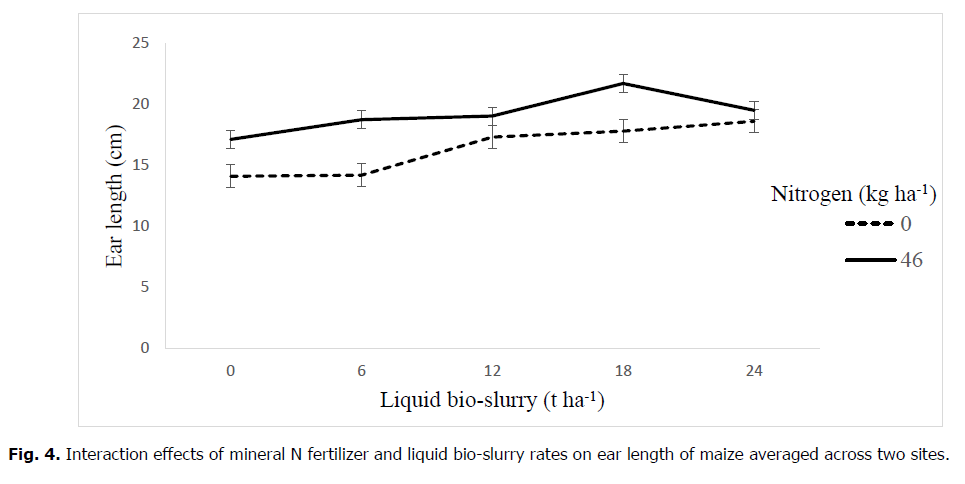
Fig. 4. Interaction effects of mineral N fertilizer and liquid bio-slurry rates on ear length of maize averaged across two sites.
Number of rows per ear
The interaction effects of mineral N and liquid bio-slurry had a significant (P≤0.05) impact on the number of rows per ear. The application of 18 t liquid bio-slurry ha-1 and 46 kg N ha-1 produced the largest number of rows ear-1 (14.4). On the other hand, the control treatment yielded the lowest number of rows per ear (9.5) (Fig. 5). The number of rows per ear was increased by 51.6% due to the combined application of N-sourced over the control. The improvement in the number of rows per ear might be attributed to the availability of nutrients needed for plant growth and an increase in ear length and diameter due to the applied mineral N fertilizer and liquid bio-slurry. Consistent with this finding, Rasheed, M., et al. 2004 found that maize had the highest number of rows per ear after applying the optimal N nutrient, which blends fertilizers made from liquid bio-slurry with mineral N. Thus, grain counts per ear-which are a function of rows per ear and the number of kernels per row-have a direct impact on grain production per unit area of maize.
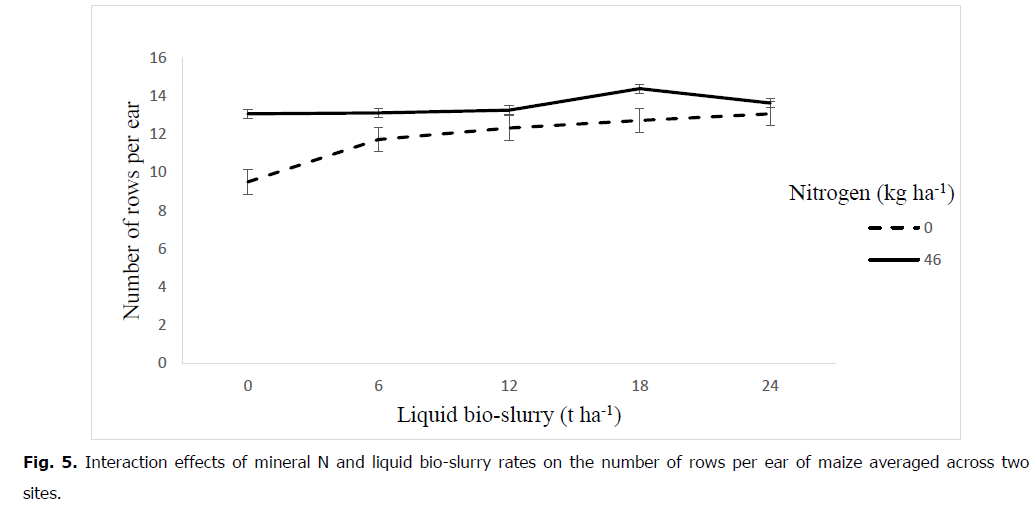
Fig. 5. Interaction effects of mineral N and liquid bio-slurry rates on the number of rows per ear of maize averaged across two sites.
Number of kernels per row
The number of kernels per row in maize significantly influences the final grain yield. The results from the present findings revealed that the interaction effects of liquid bio-slurry and mineral N had a highly significant (P≤0.01) effect on the number of kernels per row. When 18 t of liquid bio-slurry and 46 kg of N were applied together, the number of kernels per row increased by 45.02% compared to the control (Fig. 6). This might be because there is less competition for nutrients across maize crops, allowing the plant to store more biomass and convert more photosynthesis to a sink, increasing the number of kernels per row. This result is consistent with the findings of Hammad, HM., et al. 2011. Selassie, YG. 2015 also demonstrated a significant increase in the number of kernels per row of maize with an increase in the N fertilizer rate.
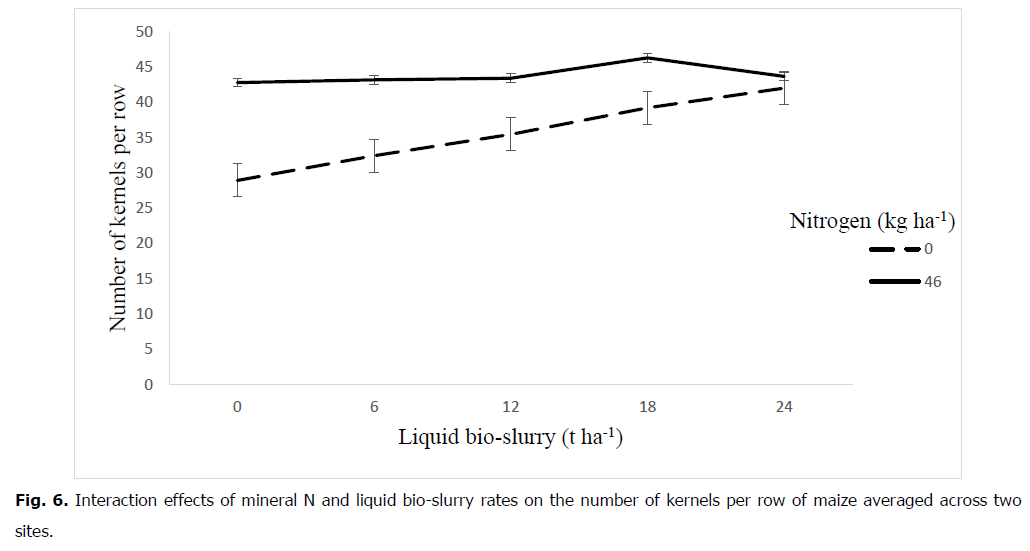
Fig. 6. Interaction effects of mineral N and liquid bio-slurry rates on the number of kernels per row of maize averaged across two sites.
Number of kernels per ear
Based on the combined analysis results from the two experimental sites, the number of kernels per ear was significantly affected (P≤0.01) by the interaction effects of mineral N and liquid bio-slurry rates. The maximum number of kernels per ear (690.4) was obtained from the plant receiving 46 kg ha-1 N with 18 t ha-1 liquid bio-slurry. However, the minimum number of kernels per ear (265.3) was recorded from the control plot (Fig. 7). The combined application of 46 kg N ha-1 with 18 t liquid bio-slurry ha-1 produced 425.1 (160%) more kernels per ear compared with the control. This is due to the fact that at maturity, approximately two-thirds of the applied N is absorbed by the plant and ends up in the kernels; as a result, the number of kernels per ear was higher in treatments that received the optimal amount of organic and inorganic fertilizer sources; and finally, this impacts the number of grains per ear and, as a result, yield potential was maximized (Belfield, S and Brown, C. 2008).
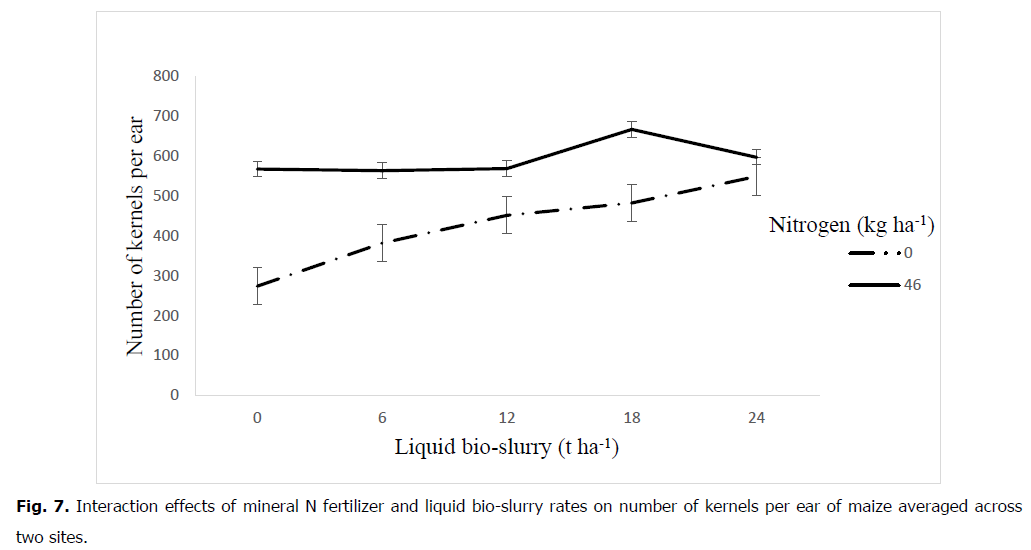
Fig. 7. Interaction effects of mineral N fertilizer and liquid bio-slurry rates on number of kernels per ear of maize averaged across two sites.
It could also be attributed to the synergistic effects of mineral N and liquid bio-slurry fertilizers, which increased nutrient use efficiencies and maize growth. The result is also consistent with the findings of Woubshet et al. (2017), who reported more kernels per spike of barley from the integrated application of 611 kg lime + 5 t compost + 150 kg NPSB + 100 kg KCl + 72 kg N ha-1 compared with the control.
Above-ground biomass yield
Above-ground biomass production, which expresses relative growth rates as a net assimilation rate, is one measure of plant development. The interaction effects of mineral N and liquid bio-slurry had a significant (P≤0.01) effect on the above-ground biomass yield of maize. The highest above-ground biomass (18.14 t ha-1) was recorded from the application of 46 kg ha-1 N and 18 t ha-1 liquid bio-slurry. The lowest (6.8 t ha-1) above-ground biomass was produced from the control plot (Fig. 8). Compared to the control plot, the application of 18 t ha-1 of liquid bio-slurry and 46 kg ha-1 of N improved the above-ground biomass yield by 11.34 t ha-1 (167%).
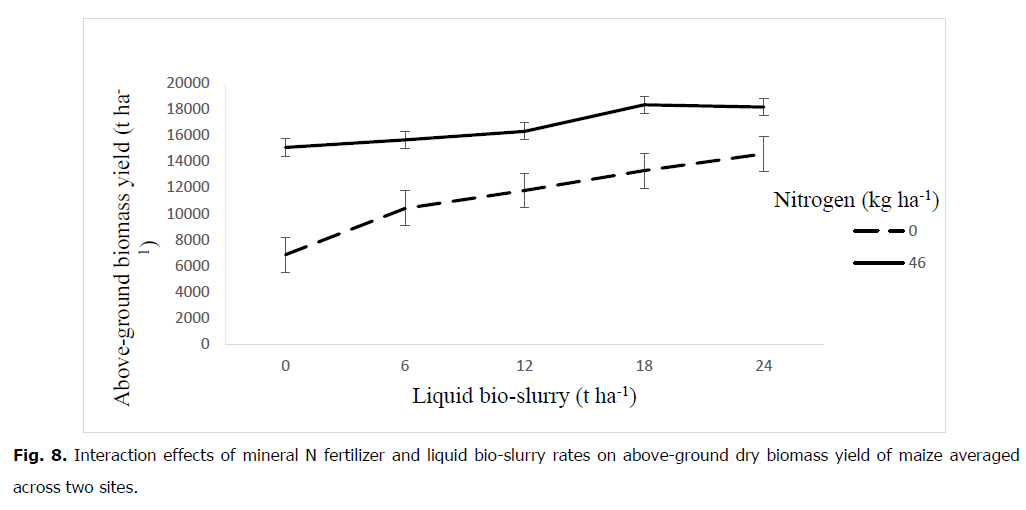
Fig. 8. Interaction effects of mineral N fertilizer and liquid bio-slurry rates on above-ground dry biomass yield of maize averaged across two sites.
In line with the present finding, Demissie, W., et al., 2017 also reported that plots treated with lime, compost, NPSB and N fertilizer yielded the highest above-ground dry biomass compared with the control plots. Similarly, Bhatt, KR., et al. 2020 reported that the combined application of organic and inorganic fertilizers improved the above-ground dry biomass yield.
Stover yield
The combined results of the study from both locations showed that the rates of liquid bio-slurry and nitrogen had significant (P≤0.01) effects on maize stover yield. The highest stover yield (10.31 t ha-1) was recorded from 46 kg ha-1 N with 18 and 24 t ha-1 liquid bio-slurry, which is 140% higher than the control. The lowest stover yield (4.3 t ha-1) was obtained from the control (Fig. 9). Such an improvement was attained because nitrogen boosted the vegetative growth, resulted in better dry matter production and consequently increased stover yield. In line with the current findings, Sanjivkumar, V. 2014 reported that the combined use of 50% organic and 50% inorganic fertilizers produced the highest stover yield and other yield components of maize compared with the sole application of organic or mineral fertilizers. Demissie, W., et al. 2017) also reported the highest mean stover yield of barley using 611 kg lime ha-1, 5 t compost, 150 kg NPSB, 100 kg KCl and 72 kg nitrogen ha-1 compared to the control. Shilpashree, VM., et al. (2012) also indicated that the use of 50% nitrogen through inorganic fertilizer plus 50% nitrogen through organic fertilizer and 75% nitrogen through inorganic fertilizers plus 75% nitrogen through organic fertilizer resulted in significantly increased stover and grain yields.
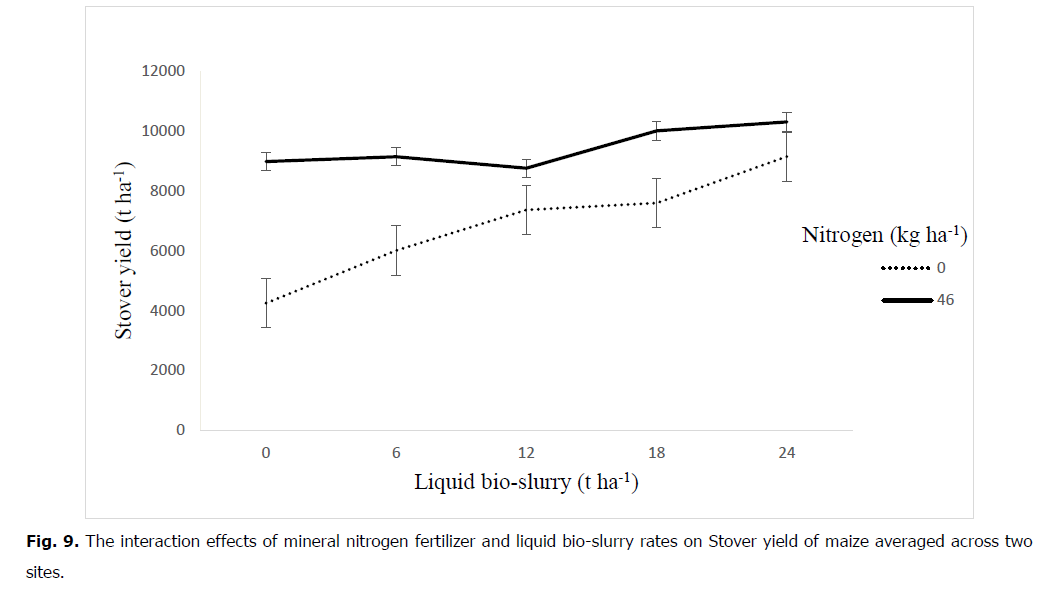
Fig. 9. The interaction effects of mineral nitrogen fertilizer and liquid bio-slurry rates on Stover yield of maize averaged across two sites.
Hundred grain weight
The combined analysis results from two sites showed that the interaction effects of mineral N and liquid bio-slurry rates (P≤0.05) had a significant (P≤0.01) effect on the hundred-grain weight. The heaviest (36.93 g) weights of hundred seeds were achieved from the combined application of 46 kg N ha-1 with 18 t liquid bio-slurry ha-1. The lowest weight of hundred seeds (27.1 g) was recorded from the control (Fig. 10). The improvement in grain weight due to the applied treatment was 9.83 g (36.3%). Such improvement in grain weight due to the applied treatments could be attributed to the synergistic effects of combining organic and mineral fertilizers for improved maize growth and grain filling. It may also be due to the applied N treatments responsible for grain filling, which improve grain thickness and integrate fragmentation with the seeds. In agreement with this result, Dinka, TB., et al., 2018 reported increased grain weight due to increased fertilizer rates from 92 kg ha-1 to 115 kg ha-1 at Bako, Western Ethiopia. Similarly, Gurmu, S and Mintesnot, A. 2020 reported that the larger ear size provided enough area for the development of an individual grain, resulting in a greater hundred-grain weight with a sufficient supply of N fertilizer and farmyard manure. Moreover, Onasanya, RO. et al., 2009 reported a higher hundred-grain weight from the higher doses of NP from organic and inorganic fertilizers than the control. Mitiku also found a maximum hundred-grain weight of barely using 5 t ha-1 of farmyard manure combined with 75% inorganic NP compared with the 100% recommended rate of mineral NP.
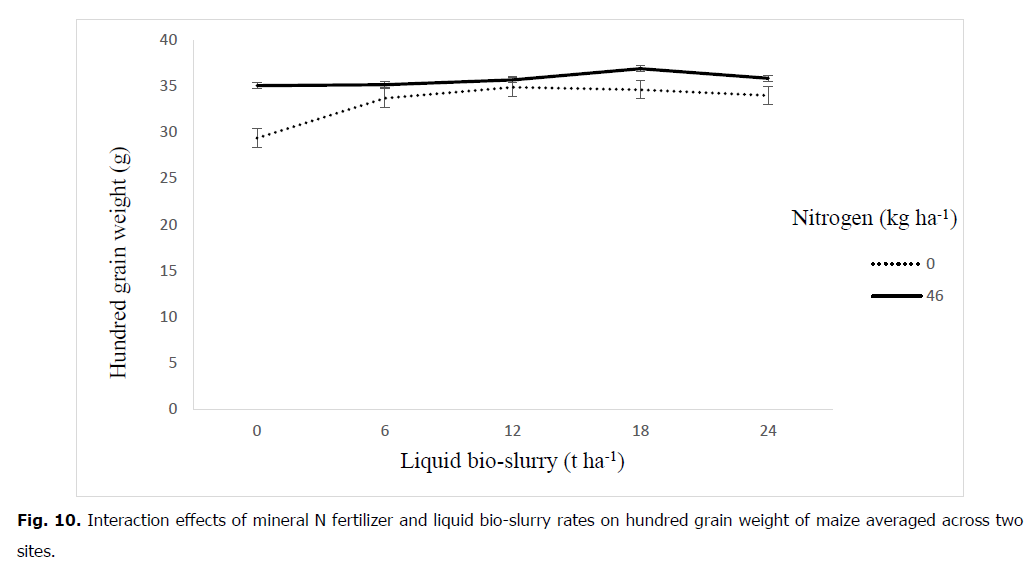
Fig. 10. Interaction effects of mineral N fertilizer and liquid bio-slurry rates on hundred grain weight of maize averaged across two sites.
Grain yield
The interaction effects of mineral N and liquid bio-slurry had significant (P≤0.05) effects on the grain yield of maize (Fig. 11). The maximum grain yield of 8.2 t ha-1 of maize was achieved by applying 46 kg ha-1 N and 18 t ha-1 liquid bio-slurry together. This was 5.07 t ha-1 (161.73%) more than the control. The lowest (3.13 t ha-1) grain yield was obtained from the control plot (Fig. 11). Such improvement could be attributed to the fact that the applied nitrogen nutrient might boost vegetative growth and influence grain production in maize (Wang, B., et al., 2019). Application of nitrogen increases the greenness of plants, CO2 assimilation rate and crop quality yield and improves resistance to environmental stresses such as limited water availability and saline soil conditions (Chen, W., et al., 2010), which contributes to the improvement of grain yield. Wang, B., et al., 2019 also found that nitrogen deficiency stress lowers crop photosynthesis by slowing leaf area development and photosynthesis rates, resulting in lower final grain production, which is consistent with the results reported in this study at the lowest rate of nitrogen.
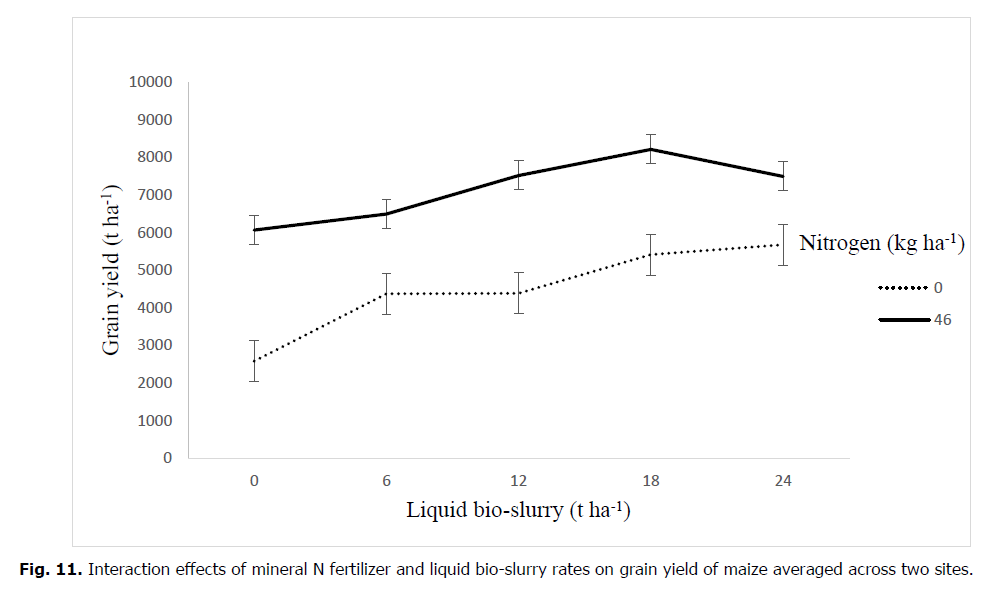
Fig. 11. Interaction effects of mineral N fertilizer and liquid bio-slurry rates on grain yield of maize averaged across two sites.
In agreement with the present findings, Dinka, TB., et al. 2018 and Naiji, M and Souri, MK. 2018 reported a better grain yield of maize from integrated nutrients compared to the recommended use of mineral or organic fertilizers alone. Similarly, Getnet, BE and Dugasa, T. 2019 reported the greatest grain yield when 120 kg N ha-1 and 60 kg P ha-1 were used together. In addition, other authors have also reported that when organic and inorganic fertilizers are used in an integrated form, the crop improvement is usually larger (Fairhurst, T. 2012; Mugwe, J., et al., 2019).
Conclusion
Achieving food security is one of the main challenges in developing countries like Ethiopia, due to the lack of access to nutritionally adequate and safe foods. One of the main challenges to the inaccessibility of sufficient and safe food in developing countries is the limited productivity of major staple foods like maize due to the continuous use of chemical fertilizer alone. Improving maize productivity through the integrated use of organic and inorganic fertilizers is highly recommended. Therefore, field experiments were conducted at two sites to determine the optimum combination of inorganic N and liquid bio-slurry for improving the productivity of maize. The results revealed that the combined use of nitrogen and liquid bio-slurry improved the growth and yield of maize in the two experimental sites. The highest grain yield (8.12 t ha-1) of maize was achieved from the combined application of 46 kg N ha-1 with 18 t liquid bio-slurry ha-1. Thus, maize producers can maximize their productivity through the integrated use of 46 kg N ha-1 with 18 t of liquid bio-slurry ha-1.
Acknowledgement
None.
Conflict of Interest
The authors declare no conflict of interest.
References
Anderson, S. A. (1990). Core indicators of nutritional state for difficult-to-sample populations. The Journal of nutrition, 120:1555-1598.
Google Scholar, Crossref, Indexed at
Zhou, D., Shah, T., Ali, S., Ahmad, W., Din, I. U., Ilyas, A. (2019). Factors affecting household food security in rural northern hinterland of Pakistan. Journal of the Saudi Society of Agricultural Sciences, 18(2):201-210.
Google Scholar, Crossref, Indexed at
Dimkpa, C. O., Fugice, J., Singh, U., Lewis, T. D. (2020). Development of fertilizers for enhanced nitrogen use efficiency-trends and perspectives. Science of the Total Environment, 731:139113.
Google Scholar, Crossref, Indexed at
Martey, E., Kuwornu, J. K., Adjebeng-Danquah, J. (2019). Estimating the effect of mineral fertilizer use on Land productivity and income: Evidence from Ghana. Land Use Policy, 85:463-475.
Google Scholar, Crossref, Indexed at
Majee, S., Halder, G., Mandal, D. D., Tiwari, O. N., Mandal, T. (2021). Transforming wet blue leather and potato peel into an eco-friendly bio-organic NPK fertilizer for intensifying crop productivity and retrieving value-added recyclable chromium salts. Journal of Hazardous Materials, 411:125046.
Google Scholar, Crossref, Indexed at
Spiertz, J. H. J. (2009). Nitrogen, sustainable agriculture and food security: A review. Sustainable agriculture, 635-651.
Google Scholar, Crossref, Indexed at
Negassa, W., Getaneh, F., Deressa, A., Dinsa, B. (2007). Integrated use of organic and inorganic fertilizers for maize production. In Utilization of diversity in land use systems: Sustainable and organic approaches to meet human needs. Conference Tropentag 9-12.
Gelaw, A. M., Singh, B. R., Lal, R. (2014). Soil organic carbon and total nitrogen stocks under different land uses in a semi-arid watershed in Tigray, Northern Ethiopia. Agriculture, ecosystems & environment, 188:256-263.
Google Scholar, Crossref, Indexed at
Sanjivkumar, V. (2014). Effect of integrated nutrient management on soil fertility and yield of maize crop (Z. mays) in Entic Haplustart in Tamil Nadu, India. Journal of Applied and Natural Science, 6(1):294-297.
Google Scholar, Crossref, Indexed at
Lal, R. (2015). Restoring soil quality to mitigate soil degradation. Sustainability, 7(5):5875-5895.
Google Scholar, Crossref, Indexed at
Elka, E., Laekemariam, F. (2020). Effects of organic nutrient sources and NPS fertilizer on the agronomic and economic performance of haricot bean (P. vulgaris L.) in Southern Ethiopia. Applied and Environmental Soil Science, 2020:1-9.
Google Scholar, Crossref, Indexed at
Powlson, D. S., Riche, A. B., Coleman, K., Glendining, M. J., Whitmore, A. P. (2008). Carbon sequestration in European soils through straw incorporation: Limitations and alternatives. Waste management, 28(4):741-746.
Google Scholar, Crossref, Indexed at
Chaudhary, S., Dheri, G. S., Brar, B. S. (2017). Long-term effects of NPK fertilizers and organic manures on carbon stabilization and management index under rice-wheat cropping system. Soil and Tillage Research, 166:59-66.
Google Scholar, Crossref, Indexed at
Salim, M. S., Mian, M., Hassan, M. (1988). Annual technical report of project improvement of soil productivity through biological mean. Pakistan Agricultural Research Council, Islamabad.
Maltsev, K., Yermolaev, O. (2020). Assessment of soil loss by water erosion in small river basins in Russia. Catena, 195:104726.
Google Scholar, Crossref, Indexed at
Maqbool, A., Ali, S., Rizwan, M., Arif, M. S., Yasmeen, T., Riaz, M., Alkahtani, S. (2020). N-fertilizer (urea) enhances the phytoextraction of cadmium through S. nigrum L. International Journal of Environmental Research and Public Health, 17(11):3850.
Google Scholar, Crossref, Indexed at
Fairhurst, T. (2012). Handbook for integrated soil fertility management. CTA/CABI.
Mugwe, J., Ngetich, F., Otieno, E. O. (2019). Integrated soil fertility management in sub-Saharan Africa: Evolving paradigms toward integration. Zero Hunger. Encyclopedia of the UN Sustainable Development Goals, 1-12.
Google Scholar, Crossref, Indexed at
Ashoka, P., Mudalagiriyappa, M., Pujari, B. T., Hugar, P. S., Desai, B. K. (2008). Effect of micronutrients with or without organic manures on yield of baby corn (Z. mays L.)-chickpea (C. artietinum L.) sequence.
Naik, I. A., Gupta, A. J. (2010). Effect of plant density and integrated nutrient management on growth, yield, quality and economics of kale (B. oleracea var. acephala) in temperate region. Indian Journal of Agricultural Sciences, 80(1):80-84.
Jinwei, Z. H. A. O., Lianren, Z. H. O. U. (2011). Combined application of organic and inorganic fertilizers on black soil fertility and maize yield. Journal of Northeast Agricultural University, 18(2):24-29.
Google Scholar, Crossref, Indexed at
Saleem, M., Javed, S., Mukhtar, R., Khan, M. K., Shoaib, M., Ikram, M., Hassan, A. (2017). Impact of different doses of nitrogen on growth and yield of maize in agro-ecological zone of district Vehari. nternational Journal of Current Research in Biology and Medicine, 2(7):34-37.
Google Scholar, Crossref, Indexed at
Warnars, L., Oppenoorth, H. (2014). A study on bioslurry results and uses. March, K. Atkinson, 20.
Islam, M. A., Begum, M., Jahangir, M. M. (2013). Effect of integrated approach of plant nutrients on yield and yield attributes of different crops in wheat-sesame-T. Aman cropping pattern. International Journal of Agricultural Research, Innovation and Technology (IJARIT), 3(2):66-71.
Google Scholar, Crossref, Indexed at
Islam, M. S. (2006). Use of bioslurry as organic fertilizer in Bangladesh agriculture. In Prepared for the presentation at the international workshop on the use of bioslurry domestic biogas programme. bangkok, Thailand, 3-16.
Islam, M. R., Rahman, S. M. E., Rahman, M. M., Oh, D. H., Ra, C. S. (2010). The effects of biogas slurry on the production and quality of maize fodder. Turkish Journal of Agriculture and Forestry, 34(1):91-99.
Google Scholar, Crossref, Indexed at
Kebede, W., Tefera, M., Habitamu, T., Alemayehu, T. (2014). Impact of land cover change on water quality and stream flow in lake Hawassa watershed of Ethiopia. Agricultural Sciences, 2014.
Google Scholar, Crossref, Indexed at
Markos, D., Worku, W., Mamo, G. (2023). Exploring adaptation responses of maize to climate change scenarios in southern central Rift Valley of Ethiopia. Scientific Reports, 13(1):12949.
Google Scholar, Crossref, Indexed at
Gebregeorgis, E. G., Zewdie, S., Wils, T. H. G., Robertson, I., Eshetu, Z., Koprowski, M. (2018). Precipitation as the main driver of the radial growth of C. lusitanica (Mill.) at Wondo genet, Ethiopia. Balt For, 24:77-85.
Yimer, F. (2017). Effect of landscape positions on soil properties in an agricultural land. A transect study in the main rift valley area of Ethiopia. Journal of Science and Development, 5(1):21-31.
Ognjenović, M., Seletković, I., Potočić, N., Marušić, M., Tadić, M. P., Jonard, M., Ugarković, D. (2022). Defoliation change of European beech (F. sylvatica L.) depends on previous year drought. Plants, 11(6):730.
Google Scholar, Crossref, Indexed at
Hazelton, P., Murphy, B. (2016). Interpreting soil test results: What do all the numbers mean?. CSIRO publishing.
Karltun, E., Mamo, T., Bekele, T., Gameda, S., Kidanu, S. (2013). Towards improved fertilizer recommendations in Ethiopia-nutrient indices for categorization of fertilizer blends from EthioSISworeda soil inventory data. Addis Ababa, Ethiopia.
Olsen, S. R. (1954). Estimation of available phosphorus in soils by extraction with sodium bicarbonate. US Department of Agriculture.
McCauley, A., Jones, C., Jacobsen, J. (2009). Soil pH and organic matter. Nutrient management module, 8(2):1-12.
Landon, J. R. (2014). Booker tropical soil manual: A handbook for soil survey and agricultural land evaluation in the tropics and subtropics. Routledge.
Mwanga, K. E. (2016). Effects of bio-slurry and farm yard manure on soil amelioration and chinese cabbage (B. Rapa Var. Chinensis) yields in Njombe region, Tanzania (Doctoral dissertation, Sokoine University of Agriculture).
Ibukunoluwa Moyin-Jesu, E. (2015). Use of different organic fertilizers on soil fertility improvement, growth and head yield parameters of cabbage (B. oleraceae L). International Journal of Recycling of Organic Waste in Agriculture, 4:291-298.
Google Scholar, Crossref, Indexed at
Muraishi, C. T., Alves, M. C., Silva Júnior, A. D., Souza, Z. M. D. (2011). Chemical attributes of a savannah Typic Hapludox soil under management systems. Acta Scientiarum. Agronomy, 33:551-557.
Google Scholar, Crossref, Indexed at
Hariadi, Y. C., Nurhayati, A. Y., Hariyani, P. (2016). Biophysical monitoring on the effect on different composition of goat and cow manure on the growth response of maize to support sustainability. Agriculture and Agricultural Science Procedia, 9:118-127.
Google Scholar, Crossref, Indexed at
Egamberdieva, D., Abdiev, A., Khaitov, B. (2016). Synergistic interactions among root associated bacteria, rhizobia and chickpea under stress conditions. Plant Environment Interaction: Responses and Approaches to Mitigate Stress, 250-262.
Google Scholar, Crossref, Indexed at
Shrestha, J. (2013). Effect of nitrogen and plant population on flowering and grain yield of winter maize. Sky Journal of Agricultural Research, 2(5):64-68.
Anwar, S., Ullah, W., Islam, M., Shafi, M., Alamzeb, A. I. M. (2017). Effect of nitrogen rates and application times on growth and yield of maize (Z. mays L.). Pure and Applied Biology (PAB), 6(3):908-916.
Google Scholar, Crossref, Indexed at
Birara Endalew, B. E., Mequanent Muche, M. M., Samuel Tadesse, S. T. (2015). Assessment of food security situation in Ethiopia.
Google Scholar, Crossref, Indexed at
Dawadi, D. R., Sah, S. K. (2012). Growth and yield of hybrid maize (Z. mays L.) in relation to planting density and nitrogen levels during winter season in Nepal.
Google Scholar, Crossref, Indexed at
Jassal, R. K., Kang, J. S., Singh, H., Singh, T. (2017). Growth, phenology and seed yield of fodder maize in relation to different planting methods and nitrogen levels. International Journal of Current Microbiology and Applied Sciences, 6(4):1723-1735.
Google Scholar, Crossref, Indexed at
Shahbaz, M., Akhtar, M. J., Ahmed, W., Wakeel, A. (2014). Integrated effect of different N-fertilizer rates and bioslurry application on growth and N-use efficiency of okra (H. esculentus L.). Turkish Journal of Agriculture and Forestry, 38(3):311-319.
Google Scholar, Crossref, Indexed at
Hammad, H. M., Ahmad, A., Wajid, A., Akhter, J. A. V. A. I. D. (2011). Maize response to time and rate of nitrogen application. Pakistan Journal of Botany, 43(4):1935-1942.
Selassie, Y. G. (2015). The effect of N fertilizer rates on agronomic parameters, yield components and yields of maize grown on Alfisols of North-western Ethiopia. Environmental Systems Research, 4:1-7.
Google Scholar, Crossref, Indexed at
Belfield, S., Brown, C. (2008). Field crop manual: Maize. A guide to upland production in Cambodia .43.
Demissie, W., Kidanu, S., Abera, T., Cherukuri, V. (2017). Effects of lime, blended fertilizer (NPSB) and compost on yield and yield attributes of Barley (H. vulgare L.) on acid soils of Wolmera District, West Showa, Ethiopia. Ethiopian Journal of Applied Science and Technology, 8(2):84-100.
Bhatt, K. R., Bhattachan, B. K., Marahatta, S., Adhikari, J. B. (2020). Growth and profitability of maize (Z. mays L.) under sole and combined applications of different organic and inorganic nutrient management at Rampur, Chitwan, Nepal. Journal of Biology and Today’s World, 9(2):214-220.
Google Scholar, Crossref, Indexed at
Shilpashree VM, Chidanandappa HM, Jayaprakash R, Punitha B.C. (2012). Influence of integrated. Nutrient Management Practices on Productivity of Maize (Z. mays L.) Crop. Indian Journal of Fundamental and Applied Life Science, 2(1):45-50
Dinka, T. B., Goshu, T. A., Haile, E. H. (2018). Effect of integrated nutrient management on growth and yield of food barley (H. vulgare) variety in toke kutaye district, west showa zone, Ethiopia. Advances in Crop Science and Technology, 6(3):1-8.
Gurmu, S., Mintesnot, A. (2020). Integrated use of nps fertilizer and compost on yield and yield component of quality protein maize (Z. mays L.) at Jimma, South Western Ethiopia. International Journal of Plant Breeding and Crop Science, 7(1), 720-737.
Onasanya, R. O., Aiyelari, O. P., Onasanya, A., Oikeh, S., Nwilene, F. E., Oyelakin, O. O. (2009). Growth and yield response of maize (Z. mays L.) to different rates of nitrogen and phosphorus fertilizers in southern Nigeria. World Journal of Agricultural Sciences, 5(4):400-407.
Wang, B., Liu, C., Zhang, D., He, C., Zhang, J., Li, Z. (2019). Effects of maize organ-specific drought stress response on yields from transcriptome analysis. BMC Plant Biology, 19:1-19.
Google Scholar, Crossref, Indexed at
Chen, W., Hou, Z., Wu, L., Liang, Y., Wei, C. (2010). Effects of salinity and nitrogen on cotton growth in arid environment. Plant and Soil, 326:61-73.
Google Scholar, Crossref, Indexed at
Naiji, M., Souri, M. K. (2018). Nutritional value and mineral concentrations of sweet basil under organic compared to chemical fertilization. Acta Scientiarum Polonorum. Hortorum Cultus, 17(2).
Google Scholar, Crossref, Indexed at
Getnet, B. E., & Dugasa, T. (2019). Response of maize yield and yield related components to different levels of nitrogen and phosphorus fertilizers. Acta Scientific Agriculture, 3(1):03-08.
Chimdi, A., Gebrekidan, H., Kibret, K., Tadesse, A. (2012). Status of selected physicochemical properties of soils under different land use systems of Western Oromia, Ethiopia. Journal of Biodiversity and Environmental Sciences, 2(3):57-71.
Teklewold, H., Kassie, M., Shiferaw, B. (2013). Adoption of multiple sustainable agricultural practices in rural Ethiopia. Journal of agricultural economics, 64(3):597-623.
Google Scholar, Crossref, Indexed at
Verma, N. K. (2011). Integrated nutrient management in winter maize (Z. mays L.) sown at different dates. Journal of Plant Breeding and Crop Science, 3(8):161-167.
Woldesenbet, M., Tana, T. (2014). Effect of integrated nutrient management on yield and yield components of food barley (H. vulgare L.) in Kaffa Zone, Southwestern Ethiopia. Science, Technology and Arts Research Journal, 3(2):34-42.
Google Scholar, Crossref, Indexed at
Habtamu, A., Heluf, G., Bobe, B., Enyew, A. (2015). Effects of organic and inorganic fertilizers on yield and yield components of maize at Wujiraba watershed, northwestern highlands of Ethiopia. American Journal of Plant Nutrition and Fertilization Technology, 5(1):1-15.
Google Scholar, Crossref, Indexed at
Hokmalipour, S., Darbandi, M. H. (2011). Effects of nitrogen fertilizer on chlorophyll content and other leaf indicate in three cultivars of maize (Z. mays L.). World Applied Sciences Journal, 15(12):1780-1785.
Chimdessa, D. (2016). Blended fertilizers effects on maize yield and yield components of Western Oromia, Ethiopia. Agriculture, Forestry and Fisheries, 5(5):151-162.
Google Scholar, Crossref, Indexed at
Rasool, S., Kanth, R., Hamid, S., Alie, B., Raja, W., Dar, Z. (2016). Effect of integrated nutrient management on yield and yield attributes of sweet corn (Z. mays L. saccharata) under wet temperate conditions of Western Himalayas (India). American Journal of Experimental Agriculture, 13(2):1-9.
Google Scholar, Crossref, Indexed at
Rasheed, M., Mahmood, T., & Ali, H. (2004). Impact of nitrogen and sulfur application on growth and yield of maize (Z. mays L.) crop. Journal of Research (Science), 15.
Golla, B., Mintesnot, A., Getachew, M. (2020). Effect of nitrogen rate and intra-row spacing on yield and yield components of maize at Bako, Western Ethiopia. African Journal of Agricultural Research, 16(10):1464-1471.
Google Scholar, Crossref, Indexed at
Zheng-rui, W., Yu-kui, R., Jian-bo, S., Fu-suo, Z. (2008). Effects of N fertilizer on root growth in Z. mays L. seedlings. Spanish Journal of Agricultural Research, 6(4):677-682.
Google Scholar, Crossref, Indexed at
Author Info
Zekarias Yohannes1, Tarekegn Yoseph2*, Alemayehu Kiflu2, Tewodros Ayalew2 and Ashenaf Haile22Department of Agriculture, Hawassa University College of Agriculture P.O.Box 05, Hawassa, Ethiopia
Citation: Yohannes, Z., Yoseph, T., Kiflu, A., Ayalew, T., Haile, A. (2024). Improving maize productivity and food security through the application of organic amendments with liquid bio-slurry. Ukrainian Journal of Ecology. 14:6-25.
Received: 06-Jan-2024, Manuscript No. UJE-24-125067; , Pre QC No. P-125067; Editor assigned: 08-Jan-2024, Pre QC No. P-125067; Reviewed: 20-Jan-2024, QC No. Q-125067; Revised: 25-Jan-2024, Manuscript No. R-125067; Published: 31-Jan-2024, DOI: 10.15421/2024_534
Copyright: This is an open access article distributed under the terms of the Creative Commons Attribution License, which permits unrestricted use, distribution, and reproduction in any medium, provided the original work is properly cited.
